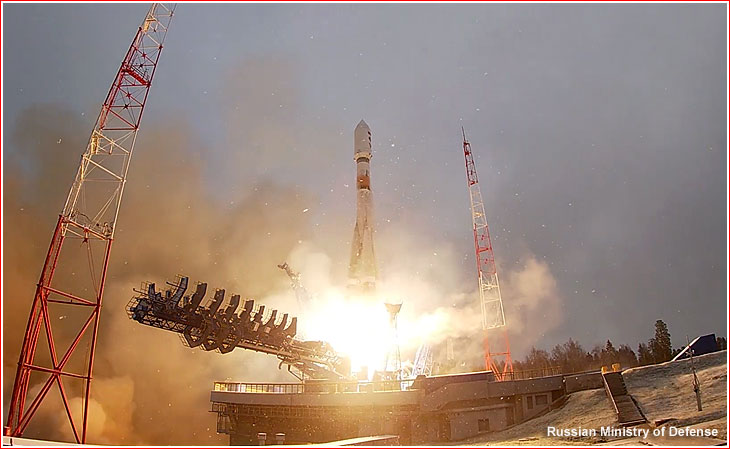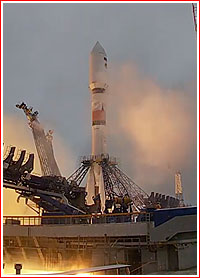|
Soyuz launches a missile-detection satellite Military personnel at Plesetsk Cosmodrome in Northern Russia fired a Soyuz-2-1b rocket on the morning of Nov. 2, 2022, carrying a classified payload which is believed to be the sixth Kupol satellite for the constellation designed to provide the Russian leadership with early warning about missile launches around the world.

Sixth Kupol/EKS launch at a glance:
According to the Russian Ministry of Defense, a Soyuz-2-1b rocket with a Fregat upper stage lifted off from Pad 4 at Site 43 in Plesetsk on Nov. 2, 2021, at 09:48 Moscow Time. No official information on the nature of the payload has been released but at the end of October, authorities in the Komi Republic issued warnings to the local population in two drop zones for the upcoming launch scheduled for Nov. 2, 2022, between 09:00 and 12:00 Moscow Time, with backup dates of November 3, 4 and 5. One closed region was at the Vashka drop zone in the Udorskiy Municipal District, matching the approximate distance downrange from Plesetsk necessary for the impact of four boosters separating from Soyuz rockets. The second closed area was at the Zheleznodorozhny drop zone, which spanned the Knyazhpogostsky and Kortkerossky Municipal Districts and it was appropriate for the impact of the payload fairing segments. Further downrange from Plesetsk, along the same flight path, a third area was later closed in the Uvatsky District of the Tyumen Region, which matched the impact site for the core booster of the Soyuz rocket. The resulting ground track indicated an ascent trajectory to an orbit inclined 64.77 degrees toward the Equator, which was used by the GLONASS navigation satellites, however, as of November 2022, the GLONASS-K2 No. 13L spacecraft, believed to be the next in line for launch into the constellation, was still undergoing final testing at its manufacturing site, according to a poster on the Novosti Kosmonavtiki forum. That left the Kupol military satellite, which was known to be prepared for launch from Plesetsk before the end of 2022 for the continuing deployment of Russia's new-generation early warning constellation. Although Kupol satellites are deployed in orbit with an inclination 63.8 degrees, the Soyuz rocket could use an available ascent corridor from Plesetsk to a 64.77-degree orbit to drop its booster stages before maneuvering to a lower inclination orbit at the expense of some lifting capability.
Approximate ground track during the launch of the EKS (Tundra) satellite. Launch profile The sixth Kupol launch likely followed the usual scenario for the deployment of satellites in the EKS constellation. The four-stage Soyuz/Fregat booster lifted off under the simultaneous thrust of the first and second stages, heading southeast from Plesetsk. The four boosters of the first stage were jettisoned around two minutes into the flight and fell around 350 kilometers downrange. The second (core) stage continued the powered ascent. The payload fairing then split into two halves around a minute after the separation of the first stage, as the rocket exited the dense atmosphere at an altitude of under 100 kilometers. Less than five minutes into the flight and moments before the second stage completed its burn, the third stage ignited its four-chamber RD-0124 engine, initially firing through the lattice structure connecting the two stages. The second stage then separated and crashed around 1,500 kilometers downrange from the launch site, northeast of the city of Tobolsk in the Tyumen Region. Around nine minutes into the flight, the third stage released the payload section, which was comprised of the Fregat upper stage and the Kupol satellite, into a suborbital trajectory before reentering the Earth's atmosphere. Any surviving debris from the third stage should have fallen into the Pacific Ocean just South East of Tasmania. Around half an hour after the launch, the Russian Ministry of Defense confirmed the fact of the liftoff and its exact time. Fregat space tug maneuvers During the orbital part of the mission, the Fregat was expected to conduct multiple maneuvers to insert the EKS satellite into its release orbit. Most likely, three main engine firings were made. The first maneuver, initiated within a minute after the separation from the third stage, likely placed the stack into an initial parking orbit. The Fregat then probably fired its engine again with the goal of stretching the orbit so that the apogee (the highest point) of this intermediate orbit reached the perigee (lowest point) of the final orbit. Finally, the third Fregat burn increased the apogee to the required altitude by firing near the peak of the target orbit. Following the separation of the EKS spacecraft, the Fregat upper stage typically conducts collision avoidance and deorbiting maneuvers. In turn, the satellite has its own propulsion system to make necessary orbit adjustments. Around six hours after the launch, the Russian Ministry of Defense said that the spacecraft had successfully entered its orbit, established reliable telemetry contact with ground control and that all its systems functioned nominally. At that point, the spacecraft was officially identified as Kosmos-2563. Within hours after the launch, the US Space Force published orbital elements for two objects associated with the launch, which were probably the satellite and the Fregat upper stage after their separation in the target orbit:
|

|